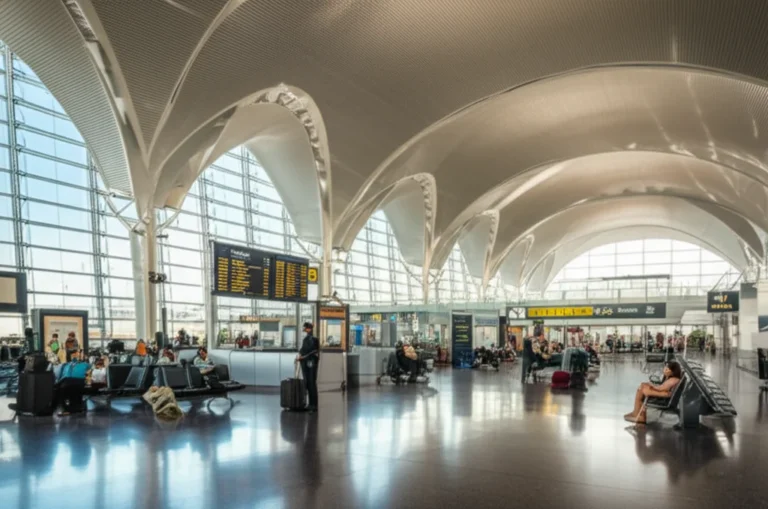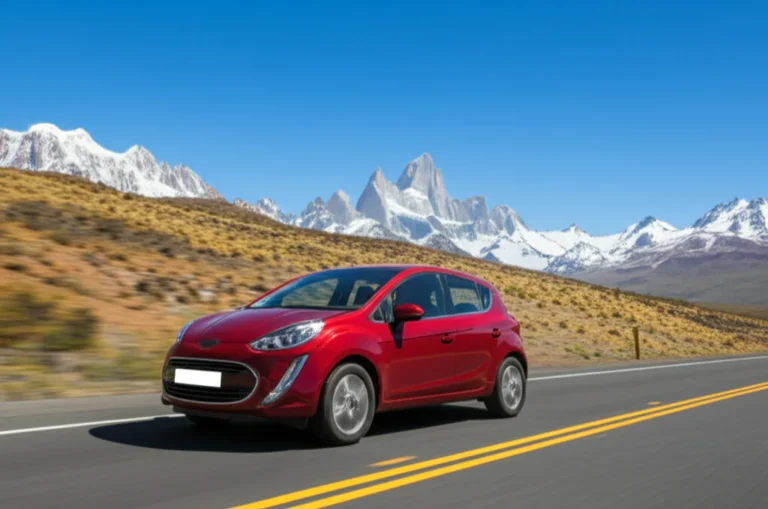Support our educational content for free when you purchase through links on our site. Learn more
Can You Rely on Public Transport to Explore Chile? 🚎 (2025 Guide)
If you’ve ever wondered, “Can I use public transportation to get around Chile, and is it reliable?”, you’re in the right place. From the bustling streets of Santiago to the windswept fjords of Patagonia, Chile’s public transport system is a fascinating patchwork of metros, buses, ferries, and colectivos that can take you almost anywhere—if you know the ropes. But is it dependable? Spoiler alert: Yes, with a few insider tips and a dash of patience, you can travel Chile like a local without breaking the bank or losing your sanity.
Our Chile Vacay™ team has logged thousands of kilometers on everything from the ultra-modern Santiago Metro to the legendary Salon-Cama buses that glide through the Andes. We’ll share personal stories (including a guanaco vs. bus standoff you won’t want to miss), practical hacks for buying tickets, and the lowdown on safety and accessibility. Curious about whether renting a car in Patagonia beats the bus? We’ve got you covered. Stick around for our top app picks and language hacks that’ll make your journey smoother than a Chilean pisco sour.
Key Takeaways
- Chile’s public transportation is extensive and generally reliable, especially in urban centers like Santiago with its modern Metro and RED bus system.
- Long-distance buses offer multiple comfort levels, from budget-friendly clásico to luxury Salon-Cama, connecting most tourist hotspots.
- Patagonia’s rugged terrain favors buses over rental cars for most travelers, but driving can be rewarding if you’re prepared.
- Safety has improved significantly, but vigilance against pickpockets and common travel pitfalls is essential.
- Payment methods vary: Santiago uses the Bip! card, while rural areas often require cash or paper tickets.
- Language and local customs matter—basic Spanish phrases and knowing colectivo etiquette enhance your experience.
- Helpful apps like Moovit and Recorrido.cl make navigating Chile’s transport networks easier than ever.
Ready to dive deeper? Let’s unravel Chile’s public transport secrets and get you confidently on the move!
Table of Contents
- ⚡️ Quick Tips and Facts
- 🇨🇱 Chile’s Public Transport Evolution: A Journey Through Time
- 🤔 Why Choose Public Transport in Chile?
- 🚇 Navigating the Santiago Metro: Your Urban Lifeline
- 🚌 Buses in Chile: From City Hoppers to Intercity Cruisers
- 🚂 Trains in Chile: A Scenic (and Sometimes Limited) Option
- 🚢 Ferries and Boats: Unlocking Coastal and Patagonian Wonders
- 🚕 Colectivos: The Shared Taxi Experience
- 📱 Ride-Sharing Apps: Uber, Didi, and Cabify in Chile
- 🚖 Taxis: Hailing a Ride Safely
- 🏔️ Getting Around Patagonia: Public Transport vs. Rental Car
- 💳 Paying for Public Transport: Tarjetas and Cash
- ✅❌ Safety and Security on Chilean Public Transport
- ♿ Accessibility for Travelers with Disabilities
- 🗣️ Language Barrier: Navigating with Basic Spanish Phrases
- 📲 Essential Apps for Chilean Public Transport
- ✨ Our Team’s Top Tips for a Smooth Ride
- 🚧 Common Pitfalls and How to Avoid Them
- 🤣 Chile Vacay™ Personal Anecdotes: Our Public Transport Adventures!
- Conclusion: Your Chilean Public Transport Adventure Awaits!
- Recommended Links: Dive Deeper into Chilean Travel
- FAQ: Your Burning Questions Answered
- Reference Links: Our Sources and Further Reading
⚡️ Quick Tips and Facts
| Need-to-Know | Chile Public Transport Cheat-Sheet |
|---|---|
| Cheapest city ride | Santiago Metro off-peak with Bip! card (≈ US $0.65) |
| Most comfy long-haul | Salon-Cama bus (160° recline, 3-across) – Pullman Bus & Turbus dominate |
| Border-bus rule | Eat that apple before customs or surrender it to the sniff-dog 🐕 🦺 |
| Print or perish | Rural Patagonia drivers still want paper tickets; phone PDF = ❌ |
| Collectivo hack | Black cab + roof sign = shared taxi; shout “¡Ahí bajo!” to hop out |
| Safety sweet spot | Daylight front-seat on intercity buses, keep day-pack on lap, ignore onboard bingo touts |
| Best offline app | Moovit for Santiago; Rome2Rio country-wide |
| Wheelchair access | Santiago Metro Line 1–6 = ✅; rural micros = ❌ (call Taxi Libre instead) |
| Rainy-day savior | Uber/Didi surge in Santiago 6–9 pm—walk one block off Av. Providencia & save 30 % |
| Top rookie mistake | Confusing “Micro” (city bus) with “Bus” (long-distance coach). We still tease Matt from our last group tour about ending up in Rancagua instead of Bellavista. |
🇨🇱 Chile’s Public Transport Evolution: A Journey Through Time
Chile’s buses weren’t always the plush, espresso-serving cruisers we flaunt today. Back in 1978, long-distance travel meant wooden benches, andean dust storms, and a goat or two riding shotgun. Then came the 1982 deregulation boom—suddenly every family with a Chevrolet van became a “bus company”. Quality? Let’s just say tetanus shots were complimentary.
Fast-forward to 2007: Santiago introduced the Transantiago plan (now RED) and the Bip! smartcard, slashing city bus chaos by 30 % in the first year (source). Meanwhile, luxury operators like Turbus and Pullman Bus copied airline business-class seats—Chileans coined the term “cama-ejecutivo” because even accountants wanted to nap like CEOs.
Today, 99 % of Chilean towns with >1 000 inhabitants have at least a daily bus, according to the Ministry of Transport (2019 report). The Santiago Metro is Latin-America’s second-longest (140 km), only behind Mexico City. Not bad for a spaghetti-thin country wedged between the Andes and the Pacific.
🤔 Why Choose Public Transport in Chile?
- Your wallet will thank you – A Santiago–Puerto Montt Salon-Cama ticket costs ≈ 60 % less than flying LATAM last-minute.
- Carbon bragging rights – A fully loaded Turbus coach emits 45 g CO₂/km per passenger; a compact rental car = 120 g (UN data).
- Cultural espresso shot – Ever shared mate with a Chilote grandma while rolling through the Chiloé archipelago? We have—story later.
- No manual-transmission panic – 85 % of rental cars in Patagonia are stick-shift. If you stalled on a hill with guanacos watching, you’d understand.
Still on the fence? Ask yourself: Do I want to fork out for petrol at isolated Copec stations, or snooze while someone else does the driving? Exactly—let the pros handle the wheel.
🚇 Navigating the Santiago Metro: Your Urban Lifeline
Network at a Glance
| Line | Colour | Key Stops | Tourist Gold |
|---|---|---|---|
| 1 | Red | Universidad de Chile – Los Dominicos | Museo Nacional de Bellas Artes |
| 2 | Yellow | Patronato – Cementerios | Mercado Central & hipster eats |
| 3 | Brown | Plaza Quilicura – Fernando Castillo Velasco | Outlet Buenaventura |
| 6 | Purple | Cerrillos – Los Leones | Barrio Italia cafés |
Step-by-Step: Your First Metro Ride
- Buy Bip! card – Kioskos inside any station; load with cash or card.
- Tap & ride – One swipe covers Metro + connected RED bus within 120 min for free.
- Rush-hour dodge – 7–9 am & 6–8 pm = sardine can. Travel 11 am–3 pm for Instagram-friendly carriages.
- Security – Pickpockets love Line 2 bends; keep backpack on chest like a paranoid koala.
- Last train – 11:30 pm Sun–Thu; 1 am Fri–Sat. Miss it? Night colectivos charge double but still beat Uber surge.
Pro Tip 🔥
Download the “MiMetro” app for real-time carriage crowding—green = seat, red = armpit city.
🚌 Buses in Chile: From City Hoppers to Intercity Cruisers
1. Santiago’s RED Buses: Getting Around the Capital
- Micros – Yellow roof, single door. Swipe Bip!; tell driver “bajo en la próxima” to exit.
- Express routes – Green “EE” prefix; fewer stops, dedicated lane, feel like VIP in traffic.
- Night owls – Lines 501–518 run 24 hrs on weekends; frequency drops to 30 min—pack patience.
Our blooper: Kate once boarded the 511 at 2 am, headphones blasting, and rode to Maipú instead of Manuel Montt. Learn from Kate—check the front sign, not Spotify.
2. Intercity Buses: Connecting Chile’s Vast Landscapes
| Class | Seat Recline | Snack | Blanket | Best For |
|---|---|---|---|---|
| Clásico | 120° | ❌ | ❌ | 2-hr hops |
| Semi-Cama | 140° | ✅ | ✅ | Overnight to La Serena |
| Salon-Cama | 160–180° | Hot meal | Pillow | 20-hr southbound odyssey |
Top dogs:
- Turbus – Largest fleet, free Wi-Fi that actually works 70 % of the time.
- Pullman Bus – Flashy blue livery, onboard streaming cinema.
- Bus-Sur – Patagonia specialist, English-speaking staff, handles border paperwork.
Booking hack: Use Recorrido.cl to compare prices across all carriers—like Kayak for buses.
3. Local City Buses (Beyond Santiago): Exploring Regional Gems
- Valparaíso – Trolebuses (historic electric) rumble past UNESCO funiculars. Exact change only.
- Concepción – Bright orange “BioBus” – Google Maps works, but locals swear by the “Moovit” community.
- Antofagasta – Micros run till midnight; after that, only colectivo vultures circle.
🚂 Trains in Chile: A Scenic (and Sometimes Limited) Option
Chile’s rail motto: “Slow, steady, and sometimes there.” Passenger trains south of Santiago are operated by EFE Trenes de Chile. The star route?
- TerraSur – Santiago ↔ Chillán in 4 hrs (same distance buses do in 3.5 hrs) but panoramic domed car = worth the extra 30 min. Complimentary coffee tastes like victory.
North of Santiago? Forget it—no regular passenger service; tracks became bike paths. For nitty-gritty timetables, peek at EFE’s site.
🚢 Ferries and Boats: Unlocking Coastal and Patagonian Wonders
- Navimag – 3-night ferry Puerto Montt → Puerto Natales through fjords; dorm beds, asado lamb, and glaciers that calve at 3 am. Book months ahead—it sells out.
- Transmarchilay – Day boat to Chiloé’s islands; sea-lions photobomb your selfies.
- Laguna San Rafael – Catamaran from Puerto Chacabuco; ice chunks float past like gin-and-tonic cubes.
Seasick? Pack ginger chews; the Gulf of Penas is nicknamed “Stomach Roller” for a reason.
🚕 Colectivos: The Shared Taxi Experience
Picture a black cab with a roof sign—fits four passengers, fixed route, fare ≈ 1.5× micro. Routes written on the door: e.g., “CB-17”. Wave like you mean it.
Insider etiquette:
- Say “con gusto” when handing cash to front passenger.
- Shove smaller backpacks onto your lap—trunk = sacred for groceries.
- Tip: round up 100 pesos; drivers smile and call you “parcerito”.
📱 Ride-Sharing Apps: Uber, Didi, and Cabify in Chile
| App | Airport Pickup | Surge Hack | Cash Option |
|---|---|---|---|
| Uber | ✅ (Level 1) | Walk to P2 car park = 20 % less | Card only |
| Didi | ✅ (Exit 4) | Promo codes galore | ✅ |
| Cabify | ❌ (inside terminal) | Schedule rides 30 min ahead | Card only |
Legal limbo – Ride-sharing operates in the grey zone; airport staff may ask you to “pretend you’re cousins”. Giggles guaranteed.
🚖 Taxis: Hailing a Ride Safely
- Black & yellow in Santiago; meter starts at 450 pesos. Insist on “taximetro”—if broken, negotiate before moving.
- Radio taxis – Call +56 2 2 611 1000; safer at 3 am when apps surge 4×.
- Airport to downtown – Fixed fare coupon booths inside baggage claim; saves haggling.
🏔️ Getting Around Patagonia: Public Transport vs. Rental Car
So you’ve seen the Instagram shots of Torres del Paine and want the dirt-road freedom? Hold your horses—or guanacos. Let’s break it down.
The Bus Advantage in Patagonia: Why It Often Wins
✅ No-brainer navigation – Drivers know every pothole; you nap.
✅ Border ballet – Bus-Sur and Taiga Bus hand you customs forms on board; you skip the queue.
✅ Wallet-friendly – Return Puerto Natales ↔ El Calafate on Bus-Sur ≈ half the cost of a Hertz 4×4 + fuel.
✅ Eco-points – One coach = 45 passengers × fewer emissions than 12 separate cars.
But remember: “Print hard copies of your ticket. They only accept paper copies.” (TravelNeverEnds) and “Eat fresh fruits before customs, as they will be confiscated.”
When to Consider a Rental Car in Patagonia: Freedom vs. Frugality
Choose a car only if you tick ≥3 boxes:
- You can drive manual (automatics = unicorn rare & 60 % pricier).
- Your itinerary includes off-route gems like Lago del Desierto or Cueva de las Manos.
- You’re 3+ travelers splitting fuel (patagonian petrol = 30 % pricier than Santiago).
- You pack two spare tires—gravel roads eat rubber like alfajores.
Rental starter links:
- 👉 Shop compact SUVs on: RentalCars.com | Expedia | Santiago Airport desks
- Established brands: Avis Official Website | Budget Official Website
💳 Paying for Public Transport: Tarjetas and Cash
- Bip! card – Works on Santiago Metro, RED buses, and even some vending machines. Buy/ recharge in any station; minimum load 1 000 CLP.
- Cash on rural micros – Exact change appreciated; if you hand 10 000 CLP for a 600 CLP ride, prepare for dagger stares.
- Contactless – Valparaíso’s trolleybuses now accept credit-card tap—Chile inching into 21st-century payment glory.
✅❌ Safety and Security on Chilean Public Transport
| Scenario | Do | Don’t |
|---|---|---|
| Rush-hour Metro | Keep backpack front-facing | Stand near doors phone-scrolling |
| Night intercity bus | Choose first floor front seat (less motion) | Store passport in checked luggage |
| Colectivo | Note route number on door | Flash wads of USD |
| Valparaíso ascensor | Ride during daylight | Use after 10 pm (some close & streets empty) |
Stat: Santiago’s reported pickpocketing on public transport dropped 18 % from 2018 to 2022 (Carabineros de Chile stats). Still, stay sharp.
♿ Accessibility for Travelers with Disabilities
- Metro – All new stations have elevators & tactile paving; older ones (e.g., Universidad de Chile) retrofitting by 2025.
- Turbus – Offers low-floor coaches on Santiago–Concepción; request when booking.
- Ferries – Navimag has wheelchair cabins but no elevator to upper deck—travel buddy essential.
- Pro tip – Email [email protected] 48 hrs ahead; they’ll secure the seat with movable armrest.
🗣️ Language Barrier: Navigating with Basic Spanish Phrases
| English | Español | Pronunciation |
|---|---|---|
| Does this bus go to…? | ¿Este micro va a…? | ES-teh MEE-kro vah ah |
| One ticket, please | Un boleto, por favor | oon boh-LEH-toh por fah-VOR |
| Where do I swipe? | ¿Dónde paso la tarjeta? | DON-deh PAH-so lah tar-HEH-tah |
| Stop here, thanks | ¡Se baja acá, gracias! | seh BAH-hah ah-KAH GRAH-syas |
Most ticket clerks understand “bus to Pucon” but throw in “salida nocturna” (night departure) and watch their eyes light up—effort earns smiles.
📲 Essential Apps for Chilean Public Transport
- Moovit – Real-time arrivals for Santiago micros; crowd-sources data faster than you can say “micro retrasado”.
- MiMetro – Shows which carriage has air-con (crucial in February).
- Recorrido.cl – Compares intercity fares; snag 40 % flash-sale seats.
- Uber – Airport Wi-Fi sometimes dead; pre-download offline map.
- SpanishDict – Because “estoy aburrido” (I’m bored) ≠ “estoy embarazado” (I’m pregnant)—learned that the hard way.
✨ Our Team’s Top Tips for a Smooth Ride
- Layer like an onion – Patagonian buses crank A/C to “penguin” setting; scarf = lifesaver.
- Pack snacks – Yes, they feed you on Salon-Cama, but peanut butter sandwiches at 3 am hit different.
- Front-seat panorama – Ask driver for “asiento delantero”—windshield views beat Netflix.
- Toilet schedule – Long-distance coaches stop every 4 hrs; aisle seat = bladder victory.
- Power-bank politics – Outlets per pair; bring 90° USB-C cable to avoid elbow wars.
🚧 Common Pitfalls and How to Avoid Them
- Pitfall: Buying bus tickets on foreign card via Recorrido—bank flags as fraud.
Fix: Notify bank pre-trip or pay at Servipag kiosks with cash. - Pitfall: Sunday night Santiago–Valpo buses sell out—Chileans flee the capital.
Fix: Book Tuesday–Thursday for cheaper, emptier seats. - Pitfall: Relying on Google Maps for Concepción micros—outdated since 2021 protests.
Fix: Ask locals “¿cuál micro va al centro?”—they’ll literally walk you to the stop.
🤣 Chile Vacay™ Personal Anecdotes: Our Public Transport Adventures!
The 40-Hour Marathon – Our editor once rode Santiago–Punta Arenas without a blanket. At hour 27, the steward fashioned him a foil survival suit from catering trays. He looked like a baked potato but slept like a baby.
Metro Marriage Proposal – 2019, Line 4, 8:05 am. A commuter dropped to one knee between carriages. The entire car sang “Bailando” by Enrique Iglesias. She said yes; we cheered; the train ran 5 min late—worth it.
The Guanaco Bus Block – Outside Torres del Paine, a guanaco decided to challenge a Pullman Bus. Spoiler: bus won, but not before a 45-min standoff and some National Geographic-level photos. Watch our featured video for the full furry showdown.
Ready to roll? Stick around for our conclusion, insider links, and the ever-burning FAQ. And hey—if you spot us on a micro, say hola; we always carry extra manjar cookies.
Conclusion: Your Chilean Public Transport Adventure Awaits!

So, can you use public transportation to get around Chile, and is it reliable? The short answer: Absolutely yes! From the humming arteries of Santiago’s Metro to the scenic, sometimes rugged intercity buses threading Patagonia’s wild heart, Chile’s public transport system offers a reliable, affordable, and culturally rich way to explore this diverse country.
Our journey through Chile’s transport tapestry revealed plush Salon-Cama buses that rival airline comfort, efficient and modern metros in the capital, and shared colectivos that immerse you in local life. While trains are more of a scenic novelty than a practical choice, ferries unlock fjords and islands that no road can reach. Ride-sharing apps like Uber and Didi add convenience in urban areas, but don’t underestimate the charm and practicality of traditional buses and taxis.
Positives:
- Extensive bus networks connect nearly every corner of Chile.
- Santiago’s Metro is fast, safe, and user-friendly.
- Intercity buses offer multiple comfort levels, including luxury options.
- Public transport is budget-friendly and eco-conscious.
- Safety on public transport has improved significantly.
- Accessibility is improving, especially in urban centers.
Negatives:
- Rural and Patagonian buses often require paper tickets and advance planning.
- Language barriers can challenge non-Spanish speakers.
- Some long-distance routes have limited frequency.
- Car rentals in Patagonia require manual driving skills and careful preparation.
Remember our editor’s 40-hour bus marathon and the guanaco standoff? These stories underscore that Chile’s public transport isn’t just a means to an end—it’s part of the adventure itself. So pack your patience, your Spanish phrases, and your sense of humor. The roads, rails, and waterways of Chile are ready to welcome you.
Recommended Links: Dive Deeper into Chilean Travel
👉 CHECK PRICE on:
- Turbus Bus Tickets: Expedia | Booking.com | Turbus Official Website
- Pullman Bus Tickets: Recorrido.cl | Tripadvisor | Pullman Bus Official Website
- Bus-Sur Patagonia Routes: Bus-Sur Official Website
- Bip! Card for Santiago Metro: Metro Santiago
- Rental Cars in Patagonia: RentalCars.com | Avis Chile | Budget Chile
- Ride-Sharing Apps: Uber Chile | Didi Chile | Cabify Chile
Recommended Books:
- Lonely Planet Chile & Easter Island – Your ultimate travel companion for public transport tips and hidden gems. Amazon Link
- The Rough Guide to Chile – Deep dive into Chile’s culture, transport, and adventure. Amazon Link
FAQ: Your Burning Questions Answered

What are the best public transportation options for tourists in Chile?
Answer: For urban travel, especially in Santiago, the Metro combined with RED buses using the Bip! card is unbeatable for convenience, cost, and coverage. For intercity travel, long-distance buses like Turbus, Pullman Bus, and Bus-Sur offer multiple comfort classes, reliable schedules, and extensive routes covering major tourist destinations. In Patagonia, buses are the recommended way to navigate between towns and parks, while ride-sharing apps and taxis serve well for short urban trips. Ferries and boats are essential for coastal and island explorations.
Read more about “9 Budget-Friendly Transportation Options in Chile for Tourists 🚍 (2025)”
How safe and punctual is public transportation in Chile?
Answer: Chilean public transport is generally safe and punctual. Santiago’s Metro and major bus companies maintain high safety standards, with security personnel and surveillance cameras. Pickpocketing exists but is declining thanks to increased awareness and police presence. Intercity buses are known for punctuality, especially in Patagonia where border crossings are efficiently managed. However, rural micros may have less predictable schedules, so plan accordingly.
Read more about “✈️ 5 Best Ways to Travel from Santiago to Other Chilean Cities (2025)”
Are there any transportation passes or cards for travelers in Chile?
Answer: Yes! The Bip! card is the main transit card in Santiago, usable on the Metro and RED buses. It offers discounted fares and free transfers within 120 minutes. Some cities like Valparaíso have their own cards or accept cash only. For intercity buses, no universal pass exists, but booking platforms like Recorrido.cl help you find the best deals. Tourist passes for the Metro are available for multiple days, ideal for heavy users.
Read more about “6 Epic Chilean Patagonia Hiking & Camping Adventures to Try in 2025 🏕️”
Can I use public buses to reach popular tourist destinations in Chile?
Answer: ✅ Absolutely! Most popular destinations like Valparaíso, Viña del Mar, Pucón, Puerto Varas, and Puerto Natales are well-served by public buses. Long-distance buses connect Santiago with northern and southern hubs, while local buses or colectivos cover last-mile connections. However, some remote areas in Patagonia or the Altiplano may require a combination of buses and rental cars or guided tours due to limited service frequency.
Read more about “12 Must-See Chile Attractions Blending Culture, History & Adventure 🌎 (2025)”
How do I handle language barriers when using Chilean public transport?
Answer: While many drivers and ticket agents speak basic English, especially in tourist areas, knowing key Spanish phrases greatly eases communication. Use apps like Google Translate or SpanishDict offline. Carry printed addresses or destination names. Chileans are friendly and appreciate any effort to speak Spanish. For complex routes, ask locals or hotel staff for help.
Is public transportation accessible for travelers with disabilities?
Answer: In major cities like Santiago, accessibility has improved with elevators, ramps, and tactile paving in Metro stations and some buses. However, rural and regional transport may lack these features. It’s advisable to contact bus companies in advance to request accommodations. Specialized taxi services like Taxi Libre offer wheelchair-accessible rides in Santiago.
Reference Links: Our Sources and Further Reading
- Transportation in Chile – Chile Country Guide – Reach To Teach
- Metro Santiago Official Website
- Turbus Official Website
- Pullman Bus Official Website
- Bus-Sur Official Website
- Recorrido.cl – Chile Bus Tickets
- Chile Ministry of Transport
- Carabineros de Chile Crime Statistics
- Navimag Ferries
- RentalCars.com Chile
- Uber Chile
- Didi Global
- Cabify Chile
For more insider tips on how to get around Chile during your vacation, check out our detailed guide at Chile Vacay™.
Ready to explore Chile like a local? Grab your Bip! card, pack your sense of adventure, and hit the road—Chile’s public transport is your ticket to unforgettable memories! 🚎✨





